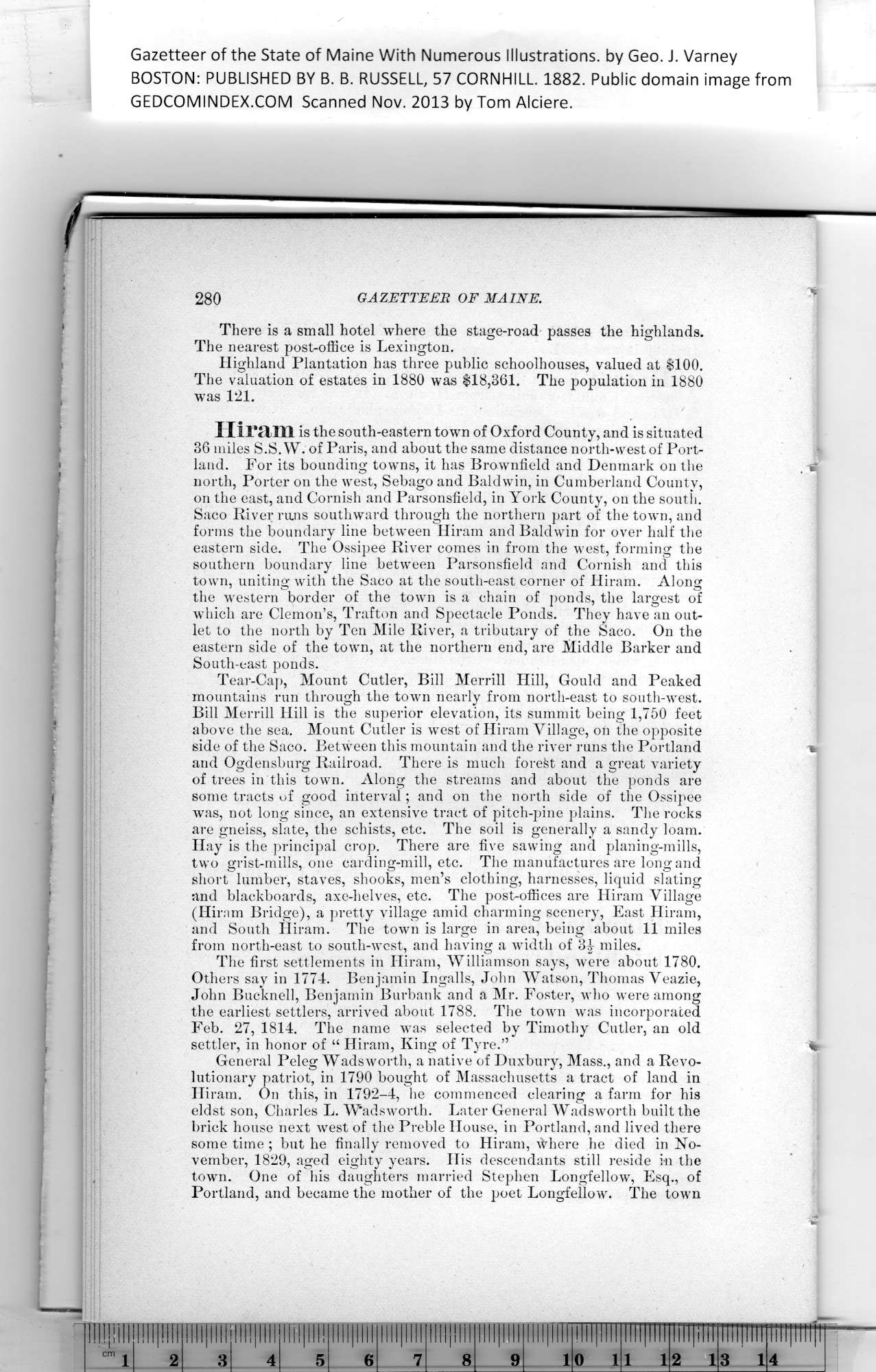|
Gazetteer of the State of Maine With Numerous Illustrations, by Geo. J. Varney
BOSTON: PUBLISHED BY B. B. RUSSELL, 57 CORNHILL. 1882. Public domain image from
280 GAZETTEER OF MAINE.
There is a small hotel where the stage-road passes the highlands.
The nearest post-office is Lexington.
Highland Plantation has three public schoolhouses, valued at $100.
The valuation of estates in 1880 was $18,361. The population in 1880
was 121.
Hiram is the south-eastern town of Oxford County, and is situated
36 miles S.S. W. of Paris, and about the same distance north-west of Port-
land. For its bounding towns, it has Brownfield and Denmark on the
north, Porter on the west, Sebago and Baldwin, in Cumberland County,
on the east, and Cornish and Parsonsfield, in York County, on the south.
Saco River runs southward through the northern part of the town, and
forms the boundary line between Hiram and Baldwin for over half the
eastern side. The Ossipee River comes in from the west, forming the
southern boundary line between Parsonsfield and Cornish and this
town, uniting with the Saco at the south-east corner of Hiram. Along
the western border of the town is a chain of ponds, the largest of
which are demon’s, Trafton and Spectacle Ponds. They have an out-
let to the north by Ten Mile River, a tributary of the Saco. On the
eastern side of the town, at the northern end, are Middle Barker and
South-east ponds.
Tear-Cap, Mount Cutler, Bill Merrill Hill, Gould and Peaked
mountains run through the town nearly from north-east to south-west.
Bill Merrill Hill is the superior elevation, its summit being .1,750 feet
above the sea. Mount Cutler is west of Hiram Village, on the opposite
side of the Saco. Between this mountain and the river runs the Portland
and Ogdensburg Railroad. There is much forefct and a great variety
of trees in this town. Along the streams and about the ponds are
some tracts of good interval; and on the north side of the Ossipee
was, not long since, an extensive tract of pitch-pine plains. The rocks
are gneiss, slate, the schists, etc. The soil is generally a sandy loam.
Hay is the principal crop. There are five sawing and planing-mills,
two grist-mills, one carding-mill, etc. The manufactures are long and
short lumber, staves, shooks, men’s clothing, harnesses, liquid slating
and blackboards, axe-helves, etc. The post-offices are Hiram Village
(Hiram Bridge), a pretty village amid charming scenery, East Hiram,
and South Hiram. The town is large in area, being about 11 miles
from north-east to south-west, and having a width of 3£ miles.
The first settlements in Hiram, Williamson says, were about 1780.
Others say in 1774. Benjamin Ingalls, John Watson, Thomas Veazie,
John Bucknell, Benjamin Burbank and a Mr. Foster, who were among
the earliest settlers, arrived about 1788. The town was incorporated
Feb. 27, 1814. The name was selected by Timothy Cutler, an old
settler, in honor of “ Hiram, King of Tyre.”
General Peleg Wadsworth, a native of Duxbury, Mass., and a Revo-
lutionary patriot, in 1790 bought of Massachusetts a tract of land in
Hiram. On this, in 1792-4, he commenced clearing a farm for his
eldst son, Charles L. Wadsworth. Later General Wadsworth built the
brick house next west of the Preble House, in Portland, and lived there
some time ; but he finally removed to Hiram, where he died in No-
vember, 1829, aged eighty years. His descendants still reside in the
town. One of his daughters married Stephen Longfellow, Esq., of
Portland, and became the mother of the poet Longfellow. The town
PREVIOUS PAGE ... NEXT PAGE
This page was written in HTML using a program written in Python 3.2
|
